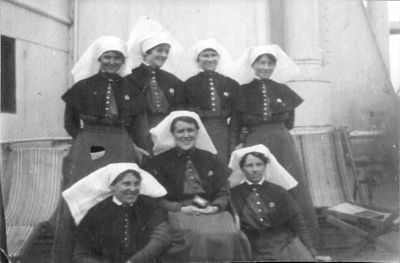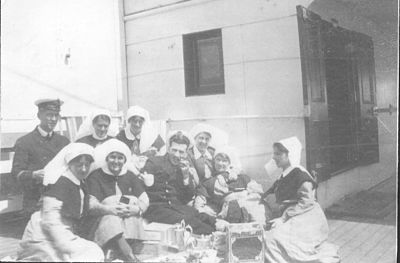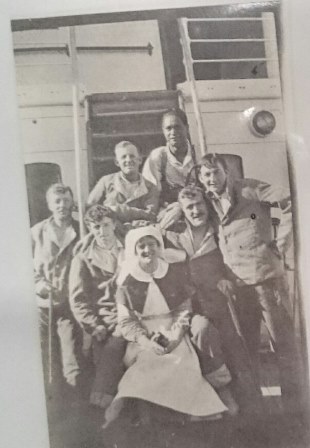WW1 Sister Bessie Maxfield (22/421) and Staff Nurse Isobel MacLennan (22/449) – Mentioned in Despatches
Bessie Maxfield was born 12 November 1886 (1887 according to the military personnel record).
She was one of seven daughters of Henry and Mary Maxfield of “Henley Grove”, 51 Market Road, Remuera. Henry (Harry) Maxfield was a successful merchant with a large grocer’s shop on the South Road and a founding member of the Remuera Bowling Club. Bessie attended Remuera Primary School and passed her state nursing examinations in June 1914. She was a nurse at Auckland Hospital, enlisting in the New Zealand Army Nursing Service (NZANS) on 8th January 1917.
She was selected for the 3rd commission of the New Zealand Hospital Ship Maheno on 19 January 1917, sailing to Mumbai, Port Said, Malta, Gibraltar, Avonmouth, Liverpool, Malta, Port Said, Suez, Colombo, Albany and back to Auckland/Wellington, for the purpose of clearing the New Zealand Hospitals in the United Kingdom and carrying patients to various ports en route as necessary.
However, when the English HM Hospital Ship Salta was mined and sunk in the English Channel in April 1917 with the loss of 9 sisters, 5 medical officers and 38 members of the Royal Army Medical Corp , the N Z Army Council decreed that all sisters were to be taken off the hospital ships. This came as a great blow to nurses in active service who were stood down from the Maheno and sent to England. Bessie was sent to the military hospital at Trentham, New Zealand.
Then the decision was rescinded; Bessie was made a sister and sailed on the 4th commission, 6th voyage, of the NZHS Maheno in October 1917, travelling to England and back. There were two more return trips to England in 1918. But it was on the troop ship Tahiti with the 40th Reinforcements in July 1918 that there was an early outbreak of influenza with a very high mortality rate, with doctors, nurses and crew afflicted. Bessie herself ended up in an isolation hospital after nursing dying men for whom very little could be done. The sisters who were on duty on the Tahiti especially Sister Maxfield, who was in charge, were mentioned in despatches in terms of the highest commendation for their splendid work and devotion to duty under the most trying circumstances. A Parliamentary Committee report into the transport ship epidemic said “Too much praise cannot be allocated to Sister Maxfield and the nurses under her charge, as all worked most assiduously and effectively to cope with the epidemic. It is regretted that the same cannot be said about the medical orderlies, who were apparently ill-trained and did not show any marked capability or zeal.” (1) It was recommended that she be given the Royal Red Cross, but there had been a new rule made that this should only be awarded after a term of service which she had not yet reached. Image: H M Transport S S Tahiti 1915 by David J Aldersley.
She returned to New Zealand on August 1919 and left active service in in the NZANS in February 1920. In 1921 Bessie was reported as leaving the military nursing service in order to look after her parents. Bessie married Joseph West and had 2 sons and a daughter. Joseph was the manager of the National Bank in Whangarei. Bessie inherited the Henley Grove house in Market Road after the death of her father in 1932. Bessie died in 1974 and was cremated at Purewa Cemetery in Meadowbank, Auckland on 5 August 1974. Bessie is remembered on the Remuera Primary School gates and the St Luke’s Presbyterian Church Roll of Honour (see picture below).
Maxfield Place off Market Road, Epsom is recorded as being named after “Mr. J. Henry Maxfield, who lived at No. 5 around 1882-1900. Dedicated in 1951.” [2]
Also on the Tahiti was Staff Nurse Isobel MacLennan from Cluanie, 48 Victoria Avenue, Remuera. She too was mentioned in despatches in connection with the epidemic amongst the men of the 40th Reinforcements in July 1918 when travelling back to NZ. Isobel had also been on the Maheno on its 4th charter in 1917/18 with Bessie.
She went on to marry Silston Cory Wright of Parnell in 1924. Cory Wright joined Cedric Salmon, a fellow officer in the Engineers, in founding the engineering firm of Cory-Wright and Salmon. The business was based on the partners’ contacts with such major British firms as Vickers Limited and the English Electric Company, but it also represented over 50 other large engineering concerns. It supplied equipment especially for railways: electrical components for the Lyttelton–Christchurch line (1928), electric units for the Wellington–Johnsonville line (1938), and electric locomotives for the main trunk line beginning with Wellington–Paekakariki (1939–40). They lived at 4 Goldie’s Brae, Wadestown, in Wellington, the historic crescent-shaped residence known as ‘the Banana House’, a former private hospital. Isobel died in 1970 aged 80.




